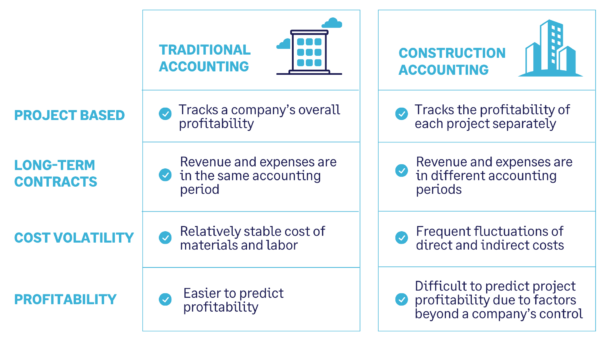Construction Accounting Made Straightforward: A Beginner's Step-by-Step Guide
Construction Accounting Made Straightforward: A Beginner's Step-by-Step Guide
Blog Article
A Comprehensive Guide to Building Audit: Optimize Your Financial Administration
Reliable monetary administration is vital in the building industry, where the intricacies of project-based earnings and costs can substantially impact overall productivity. By using finest practices in financial coverage and analysis, stakeholders can not only boost functional efficiency yet additionally alleviate potential threats.
Comprehending Building Accounting
Recognizing building accounting is essential for the successful management of economic resources in the building and construction market. This specialized branch of audit addresses the distinct challenges dealt with by construction companies, including project-based earnings recognition, price tracking, and conformity with regulative requirements. Unlike standard bookkeeping, construction accountancy requires an unique approach to handle the intricacies related to lasting contracts and changing prices.
Secret parts of construction accounting include precise profits acknowledgment, which often counts on the percentage-of-completion technique or completed-contract approach, depending on the job's nature. This makes certain that financial statements show real performance and success gradually. Job costing plays a vital function, permitting companies to track expenditures linked with details projects, which aids in determining success and resource allotment.
One more important element is the administration of capital, which is commonly affected by repayment routines and delays in receivables. Effective cash flow monitoring makes certain that building and construction firms can satisfy operational needs and purchase future tasks. Inevitably, understanding building bookkeeping gears up firms with the devices needed to make educated financial choices, minimize dangers, and enhance overall functional effectiveness in a competitive sector.

Job Costing and Budgeting
Job setting you back and budgeting are indispensable parts of building and construction accountancy that allow firms to effectively manage task funds and make sure success. Job setting you back entails the careful tracking of all prices linked with a certain project, consisting of labor, products, devices, and overhead. This procedure enables construction firms to establish the true price of finishing a job, promoting notified decision-making and improving monetary accountability.
Budgeting, on the other hand, works as a financial roadmap for tasks. It includes setting economic limitations and allocating sources to various task components, therefore establishing a structure against which real expenses can be measured. Reliable budgeting requires detailed analysis and projecting, taking into factor to consider historical information, market trends, and possible risks.
With each other, work costing and budgeting give the required devices for construction companies to monitor monetary efficiency, identify variations, and readjust techniques as required - construction accounting. By applying robust task setting you back practices and adhering to well-structured spending plans, companies can enhance their functional performance, mitigate monetary threats, try this and ultimately enhance their earnings in an affordable marketplace. Thus, these methods are essential for maintaining long-lasting success within the building and construction sector
Tracking Expenses and Income
Precisely tracking expenditures and earnings is important for building companies to keep economic wellness and ensure project practicality. Efficient tracking enables services to keep an eye on task efficiency, recognize price overruns, and make educated economic choices. Applying an organized strategy to recording all financial purchases is crucial to Visit Your URL attaining this objective.
Making use of building and construction audit software program can dramatically boost the monitoring process. These tools facilitate real-time monitoring of expenditures, consisting of labor, products, and subcontractor expenses, while also capturing earnings created from job turning points and client payments. By classifying costs and income streams, firms can gain insights into earnings and capital.

Financial Coverage and Analysis
Financial coverage and analysis play a crucial function in the construction sector, offering stakeholders with essential understandings into a company's financial efficiency and operational performance. Exact monetary records, including annual report, earnings declarations, and capital statements, are basic for evaluating the wellness of a building company. These files aid determine fads, assess task profitability, and assist in informed decision-making.
In building audit, monetary evaluation surpasses simple coverage; it entails scrutinizing monetary information to uncover underlying patterns and anomalies. Trick performance indicators (KPIs), such as gross revenue margins, task completion rates, and return on financial investment, serve as benchmarks to assess functional success. Routinely examining these metrics permits firms to identify areas needing renovation, maximize resource allotment, and improve job monitoring strategies.
Additionally, efficient monetary coverage cultivates openness and constructs trust with stakeholders, including clients, providers, and financiers - construction accounting. By preserving extensive monetary oversight, building business can alleviate threats, make certain conformity with governing demands, and ultimately drive sustainable growth. Hence, a robust financial reporting and analysis framework is vital for navigating the complexities of the building landscape and achieving long-term success
Best Practices for Success
To achieve success in construction audit, firms have to take on a collection of finest practices that streamline procedures and boost monetary administration. First, implementing a durable job administration software customized for building and construction can assist in real-time tracking of project prices and budget plans, allowing for more exact forecasting and resource appropriation.
2nd, adopting a constant approach to task setting you back is important. This includes thoroughly tracking all costs connected with each task, including labor, products, and expenses. Frequently assessing task expenses versus initial quotes aids identify variations early, making it possible for timely corrective activities.
Third, maintaining extensive paperwork techniques ensures compliance with regulations and simplifies audits. This consists of maintaining in-depth documents of agreements, adjustment orders, billings, and try this invoices.
Additionally, investing in staff training is vital. Making sure that staff members are fluent in accounting concepts, software program use, and sector criteria can significantly boost performance and precision in economic coverage.
Verdict

Report this page